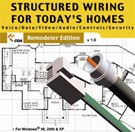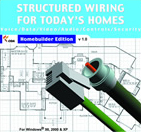Because communications wiring (for telephone, cable TV, etc.) is hidden in walls and invisible to homeowners, many people are unaware of its limitations, or their options for upgrading it.
 John Ratzenberger (Cliff Claven in Cheers, host of Made in America) clarifies these topics for homeowners and homebuyers on a tour of four homes with very different digital lifestyles. “Structured Wiring for Today’s Homes” provides a friendly overview of the concept. He points out the differences between wired and wireless solutions and shows why communications wiring is as important for entry-level homes as for sophisticated custom homes. He also touches on such topics as why buying an obsolete home (with old-style, pre-digital communications wiring) is a bad idea, and he discusses important issues relating to home remodeling and wiring retrofits.
John Ratzenberger (Cliff Claven in Cheers, host of Made in America) clarifies these topics for homeowners and homebuyers on a tour of four homes with very different digital lifestyles. “Structured Wiring for Today’s Homes” provides a friendly overview of the concept. He points out the differences between wired and wireless solutions and shows why communications wiring is as important for entry-level homes as for sophisticated custom homes. He also touches on such topics as why buying an obsolete home (with old-style, pre-digital communications wiring) is a bad idea, and he discusses important issues relating to home remodeling and wiring retrofits.
Ratzenberger introduces specialists who get into the nitty-gritty of what structured wiring is, how it works and why it’s needed. Top manufacturers, real estate agents, builders and system integrators share their experiences and expertise on a variety of fascinating topics. Altogether, Ratzenberger introduces a cast of 46 participants, who elaborate on 23 different topics.
Any of the following CDROMs in this series can be ordered going to the Telecom Publications and follow the instructions for ordering. First copy is FREE. The Homeowner Edition can be ordered online.
Structured wiring is being incorporated into an increasing percentage of new homes, and builders, installers and remodelers have many questions on whether these new technologies are right for them. Foremost among these concerns is: can I make money doing this; should I offer this as a custom or standard production feature; will my reputation be adversely affected if I build an “obsolete” house; and, are my installers capable of doing the job right.
 Installers should recognize the business and career opportunities offered by this dynamic field.
Installers should recognize the business and career opportunities offered by this dynamic field.
Low-voltage installers may enter the structured-wiring field from many directions – electrician, securities installer, systems integrator, telephone company employee, carpenter, etc.
This series of easy-to-use, free CDROMs answers these and many other questions builders, remodelers and installers have. It addresses money issues, shows what consumers are asking for, describes the basics of a structured wiring system, the details of implementation including testing, and the features and options available to builders, remodelers and installers.
The CDROMs include the opinions of dozens of interviewees, ranging from builders to homeowners, installers, realtors and manufacturers.
 Each of the topics on the CDROMs is represented by a video clip ranging from 20 seconds to 2 minutes in length. Following the clip, the user can scan frequently asked questions for expansion and clarification of the subject. Each CDROM wraps up with sources of further information for the target audience.
Each of the topics on the CDROMs is represented by a video clip ranging from 20 seconds to 2 minutes in length. Following the clip, the user can scan frequently asked questions for expansion and clarification of the subject. Each CDROM wraps up with sources of further information for the target audience.
These are not intended as how-to manuals. For a more hands-on guide, take a look at CDA’s set of two videos, Infrastructure Wiring for Existing Homes and Infrastructure Wiring for New Homes. They provide 3½ hours of instruction on techniques and tools for running wire. They are available for purchase through the same sources as the CDROMs.
